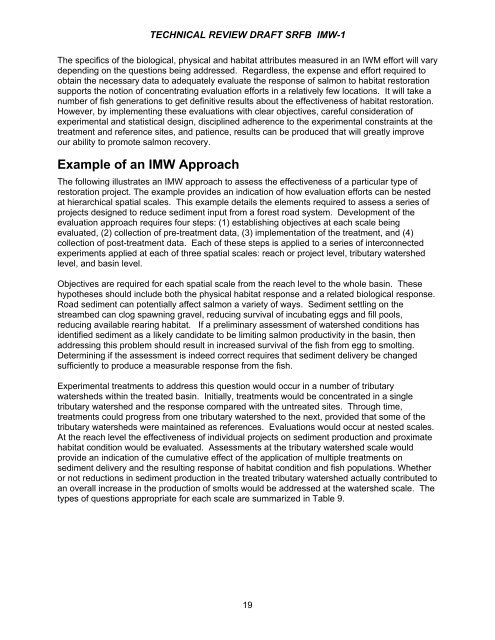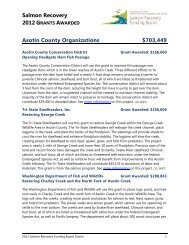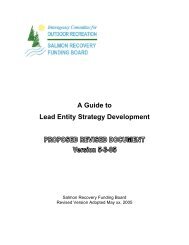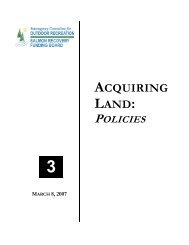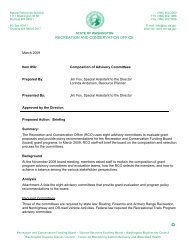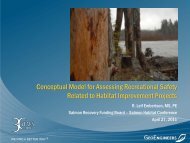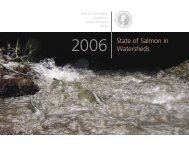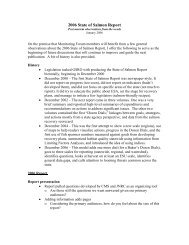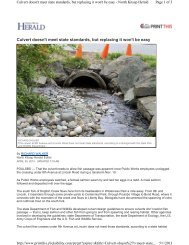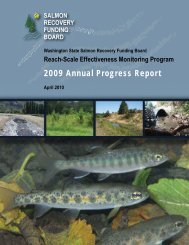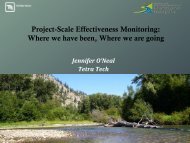TECHNICAL REVIEW DRAFT SRFB IMW-1can enable salmon response <strong>to</strong> individual res<strong>to</strong>ration projects <strong>to</strong> be linked with response at thescale of the whole watershed. Capturing fish seasonally (spring, late summer, winter) byelectrofishing, seining or trapping at multiple locations across the watershed would enable anestimate of fish distribution, abundance, growth rate, species, and age class composition. Analternative <strong>to</strong> capturing fish is a visual survey using an extensive sampling approach like Hankin-Reeves (Hankin and Reeves 1988) although this method does not provide in<strong>for</strong>mation on fishspecies and size that is as accurate as methods that involve capturing fish, it is rapid and wouldenable sampling of the entire stream network in a WAU-sized watershed. A combination of thetwo approaches, a complete survey coupled with subsamples at selected sites where the fishare captured and measured, would provide the most complete in<strong>for</strong>mation. The methodselected will depend on how critical the measurement is, the characteristics of the site, and theresources available <strong>to</strong> be dedicated <strong>to</strong> obtaining the measurement.Differential tagging of salmon captured during the sampling of different stream reaches andsubsequent capture at the smolt trap could provide additional in<strong>for</strong>mation on survival rates offish rearing in different areas of the watershed and the effectiveness of individual res<strong>to</strong>rationprojects. Differences in survival among reaches or habitat types may provide an indication ofkey mortality fac<strong>to</strong>rs operating in the river and aid in the identification of res<strong>to</strong>ration ef<strong>for</strong>ts likely<strong>to</strong> have the greatest effect on salmon populations. There are numerous tagging technologiesavailable. Passively induced transponder (PIT) tags, which are appropriate <strong>for</strong> larger fish(>70mm) have been used extensively on the Columbia River and enable individual identificationof fish. Visible implant (VI) tags also can be used <strong>to</strong> identify individual fish although reading thetags is more difficult than with PIT tags. The injection of colored dyes or polymers in<strong>to</strong> varioustransparent tissues of the fish enables determination of the location where a fish was tagged butcannot be used <strong>to</strong> identify individual fish. However, this type of tag may be very appropriate <strong>for</strong>addressing many of the questions related <strong>to</strong> res<strong>to</strong>ration effectiveness.The collection of data on fish populations must be coupled with in<strong>for</strong>mation on the habitatattributes and climatic conditions. As fish are very sensitive <strong>to</strong> variations in flow, temperatureand other fac<strong>to</strong>rs that might not be directly influenced by res<strong>to</strong>ration treatments, interpretation ofthe fish data can be enhanced by the collection of this in<strong>for</strong>mation. At a minimum, a recordingflow gauge is required at the mouth of the reference and treatment watersheds. In addition, ifsome of the res<strong>to</strong>ration ef<strong>for</strong>ts are attempting <strong>to</strong> alter flow patterns, secondary flow gaugesshould be installed at the locations where these ef<strong>for</strong>ts are undertaken. A weather stationcollecting data on precipitation and air temperature should be located near the downstream endof the watershed. Water temperature also should be recorded year round at each gaugingstation and at all sites where one of the purposes of a res<strong>to</strong>ration action is <strong>to</strong> alter watertemperature. Instruments <strong>to</strong> record flow, weather and water temperature in<strong>for</strong>mation data haveimproved dramatically in the last decade and costs have decreased. Thus, costs are reasonable<strong>for</strong> installing this equipment. However, maintaining the instruments and the database are laborintensive.Data on habitat can be collected concurrently with fish sampling. These data are especiallyimportant at sites where res<strong>to</strong>ration projects will be implemented. Habitat data can includephysical characteristics of the channel (e.g., pools, riffles etc.), riparian area condition, levels ofsediment deposited in pools and in spawning gravel, water quality (e.g., temperature,suspended sediment), nutrient levels and trophic productivity. The variables measured willdepend on the objectives of the res<strong>to</strong>ration actions. Projects designed <strong>to</strong> increase pool habitatwill focus on the physical attributes of the channel while measures of nutrient levels and trophicproduction would be the most appropriate measures of a salmon carcass addition project.18
TECHNICAL REVIEW DRAFT SRFB IMW-1The specifics of the biological, physical and habitat attributes measured in an IWM ef<strong>for</strong>t will varydepending on the questions being addressed. Regardless, the expense and ef<strong>for</strong>t required <strong>to</strong>obtain the necessary data <strong>to</strong> adequately evaluate the response of salmon <strong>to</strong> habitat res<strong>to</strong>rationsupports the notion of concentrating evaluation ef<strong>for</strong>ts in a relatively few locations. It will take anumber of fish generations <strong>to</strong> get definitive results about the effectiveness of habitat res<strong>to</strong>ration.However, by implementing these evaluations with clear objectives, careful consideration ofexperimental and statistical design, disciplined adherence <strong>to</strong> the experimental constraints at thetreatment and reference sites, and patience, results can be produced that will greatly improveour ability <strong>to</strong> promote salmon recovery.Example of an IMW ApproachThe following illustrates an IMW approach <strong>to</strong> assess the effectiveness of a particular type ofres<strong>to</strong>ration project. The example provides an indication of how evaluation ef<strong>for</strong>ts can be nestedat hierarchical spatial scales. This example details the elements required <strong>to</strong> assess a series ofprojects designed <strong>to</strong> reduce sediment input from a <strong>for</strong>est road system. Development of theevaluation approach requires four steps: (1) establishing objectives at each scale beingevaluated, (2) collection of pre-treatment data, (3) implementation of the treatment, and (4)collection of post-treatment data. Each of these steps is applied <strong>to</strong> a series of interconnectedexperiments applied at each of three spatial scales: reach or project level, tributary watershedlevel, and basin level.Objectives are required <strong>for</strong> each spatial scale from the reach level <strong>to</strong> the whole basin. Thesehypotheses should include both the physical habitat response and a related biological response.Road sediment can potentially affect salmon a variety of ways. Sediment settling on thestreambed can clog spawning gravel, reducing survival of incubating eggs and fill pools,reducing available rearing habitat. If a preliminary assessment of watershed conditions hasidentified sediment as a likely candidate <strong>to</strong> be limiting salmon productivity in the basin, thenaddressing this problem should result in increased survival of the fish from egg <strong>to</strong> smolting.Determining if the assessment is indeed correct requires that sediment delivery be changedsufficiently <strong>to</strong> produce a measurable response from the fish.Experimental treatments <strong>to</strong> address this question would occur in a number of tributarywatersheds within the treated basin. Initially, treatments would be concentrated in a singletributary watershed and the response compared with the untreated sites. Through time,treatments could progress from one tributary watershed <strong>to</strong> the next, provided that some of thetributary watersheds were maintained as references. Evaluations would occur at nested scales.At the reach level the effectiveness of individual projects on sediment production and proximatehabitat condition would be evaluated. Assessments at the tributary watershed scale wouldprovide an indication of the cumulative effect of the application of multiple treatments onsediment delivery and the resulting response of habitat condition and fish populations. Whetheror not reductions in sediment production in the treated tributary watershed actually contributed <strong>to</strong>an overall increase in the production of smolts would be addressed at the watershed scale. Thetypes of questions appropriate <strong>for</strong> each scale are summarized in Table 9.19


